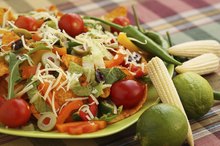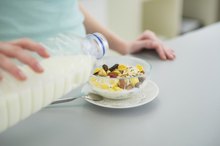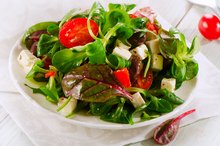A 28-Day Meal Plan
If you want to lose weight, lower your blood pressure, reduce blood glucose levels, reduce cholesterol or just stay healthy, a 28-day meal plan can help. Your meal plan should include complex carbohydrates such as whole grains, fruits, vegetables, legumes, seeds and nuts as well as lean protein, low-fat dairy and heart-healthy fats.
Carbohydrates
Get 40 to 65 percent of your calories from carbohydrates. If you follow a 2,000-calorie-a-day, diet, this amounts to 900 to 1,300 calories or 225 g to 325 g of carbohydrates. Each gram of carbohydrates contains about 4 calories 2. If you consume more or fewer than 2,000 calories a day, adjust your carbohydrate consumption accordingly. Plan breakfasts on a 28-day meal plan around carbohydrates such as:
- oatmeal
- bran
- whole-grain bread
- blueberries
- raspberries
- bananas
- almonds
- walnuts
- seeds
Carbohydrates to include
- spinach
- romaine lettuce
- tomatoes
- sprouts
- multigrain bread
- apples
- oranges
- pears
For dinner, stock up on carbohydrates such as
- peas
- corn
- Get 40 to 65 percent of your calories from carbohydrates.
- If you follow a 2,000-calorie-a-day, diet, this amounts to 900 to 1,300 calories or 225 g to 325 g of carbohydrates.
Protein
Eco-Atkins Diet Plan Menu
Learn More
On your 28-day meal plan, include 10 to 35 percent of your calories from protein. This amounts to about 2 oz. to 6 oz. of protein on a 2,000-calorie-a-day diet. This means you can easily include meatless meals on your 28-day meal plan and meet your protein needs. You will keep unhealthy saturated fat in your diet low if you include lean animal protein and vegetable protein in your diet. At breakfast, good protein choices include:
- egg whites
- nonfat milk
- plain
- nonfat yogurt
- low-fat cottage cheese
- lean baked ham
- nuts
- seeds
At lunch, avoid processed luncheon meats. Include 1 oz. to 2 oz. of meat or cheese in your lunches or about 1/2 cup of beans. Other good choices for lunchtime protein include veggie burgers and skinless chicken. At dinner, limit protein portions to about 3 oz. Lean choices include salmon, halibut, baked ham, turkey burgers and tofu.
- On your 28-day meal plan, include 10 to 35 percent of your calories from protein.
Fat
Include fat on your 28-day meal plan, but emphasize healthy fats, such as those from olives, pumpkins and avocados. Keep saturated fat to 16 to 22 grams a day and trans fat to less than 2 grams a day. Animal products provide the main source of saturated fat. Avoid fatty meat, such as beef short ribs, pork chops and hamburger. Butter, cheese and whole dairy products also contain a lot of saturated fat. To keep trans fat low, avoid margarine and shortening and products that may contain them -- fried foods, commercial baked goods, snack foods and frozen potatoes. Cook with olive oil or canola oil and plan to eat about 1 oz -- a handful -- of nuts a day.
- Include fat on your 28-day meal plan, but emphasize healthy fats, such as those from olives, pumpkins and avocados.
- To keep trans fat low, avoid margarine and shortening and products that may contain them -- fried foods, commercial baked goods, snack foods and frozen potatoes.
Sample Menu Plans
7-Day Menu for Diabetics
Learn More
For breakfast, have an egg white omelet filled with vegetables and 1 oz. of low-fat cheese; a bowl of oatmeal cooked with nonfat milk and topped with banana slices and walnuts; or a slice of French toast topped with 1/2 cup cottage cheese and strawberries. For lunch, have 2 oz. of baked turkey on whole-wheat bread topped with spinach, tomatoes and mustard or a salad of romaine, blueberries, almonds and strips of skinless chicken in a mustard-yogurt dressing. For dinner try salmon with a baked sweet potato and green beans; whole-wheat spaghetti in marinara sauce with broccoli- or a tofu and vegetable stir fry.
- For breakfast, have an egg white omelet filled with vegetables and 1 oz.
- of low-fat cheese; a bowl of oatmeal cooked with nonfat milk and topped with banana slices and walnuts; or a slice of French toast topped with 1/2 cup cottage cheese and strawberries.
Related Articles
References
- USDA: Dietary Guidelines for Americans, 2010
- American Diabetes Association: Carbohydrates
- National Institute of Diabetes and Digestive and Kidney Diseases. Diabetes diet, eating, and physical activity. Published December, 2016.
- National Institute of Diabetes and Digestive and Kidney Disease. Carbohydrate counting and diabetes. Published June, 2014.
- Cleveland Clinic. Carbohydrates and blood sugar control for people with diabetes. Updated January 13, 2013.
- Evert AB, Dennison M, Gardner CD, et al. Nutrition therapy for adults with diabetes or prediabetes: A consensus report. Diabetes Care. 2019;42(5):731-754. doi:10.2337/dci19-0014
- American Diabetes Association. Protein.
- Rabinovitz HR, Boaz M, Ganz T, Jakubowicz D, Matas Z, Madar Z, Wainstein J. Big breakfast rich in protein and fat improves glycemic control in type 2 diabetics. Obesity (Silver Spring). 2014 May;22(5):E46-54. doi:10.1002/oby.20654
- American Diabetes Association. Fats.
- Maki KC, Phillips-Eakley AK, Smith KN. The effects of breakfast consumption and composition on metabolic wellness with a focus on carbohydrate metabolism. Adv Nutr. 2016;7(3):613S–21S. doi:10.3945/an.115.010314
Writer Bio
Kathryn Gilhuly is a wellness coach based in San Diego. She helps doctors, nurses and other professionals implement lifestyle changes that focus on a healthy diet and exercise. Gilhuly holds a Master of Science in health, nutrition and exercise from North Dakota State University.









